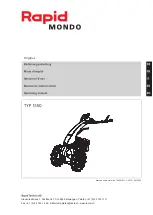
23
English
Manual – BFCS 300
Operation
Taking test samples (figures on page XIII)
Recommendation: Take the test samples
as directly as possible at the brake calli-
pers and wheel cylinders. When you take
the brake fluid, observe the fluid level in
the expansion tank.
Measurement values for samples from
the expansion tank are generally higher
than those for samples from the wheel
brakes as just one insignificant fluid ex-
change takes place in the brake system.
Brake fluid, which has been refilled in the
expansion tank, can falsify the measure-
ment result over several weeks.
Avoid falsifying the measurement results.
Use a new pipette and a new, clean sam-
ple beaker for every measuring process.
Important: Risk of damage to or destruc-
tion of the sensor head.
Do not carry
out any dry runs!
Clean the sensor head
before the first measurement. To do this,
carry out two to three measurements with
new brake fluid.
To test the brake fluid, see figures
on the fold-out page.
Testing the brake fluid
Measuring (figures on page III)
1.
Lift the measuring arm and place the
new sample beaker on the base
2.
Fill the sample beaker to the brim
using a new pipette
3.
Lower the measuring arm until the
sensor head is resting on the bottom
of the sample beaker. This will cause
some of the brake fluid to overflow,
which is collected in the sample
beaker's overflow channel
4.
Press the “Start” button
= The “Start” indicator lamp flashes.
CAUTION! Hot sensor head! Risk of
burns. Do not touch the hot sensor
head.
The current measured temperature
is shown continuously on the display
during the heating and boiling phase.
When the “Start” indicator lamp stays
on permanently, the boiling point has
been reached. The measurement value
remains visible until the next test. For
permissible measurement results, see the
table below.
CAUTION! Hot brake fluid! Risk of
burns. Leave the brake fluid to cool
before removing the sample beaker.
5.
Lift the measuring arm and remove
the sample beaker
6.
Dispose of the beaker and fluid in an
environmentally friendly manner
Summary of Contents for 03.9311-0073.4
Page 1: ...03 9311 0073 4 730085 ATE BFCS 300 ...
Page 4: ...III 1 0 2 3 4 2 1 ...
Page 5: ...IV 1 2 15 35sec Min 5 8 6 7 15 34 sec ...
Page 6: ...V ...
Page 22: ...16 Deutsch Bedienungsanleitung BFCS 300 ...
Page 38: ...32 English Manual BFCS 300 ...
Page 70: ...64 Italiano Istruzioni per l uso BFCS 300 ...
Page 102: ...96 Български Ръководство за обслужване BFCS 300 ...
Page 118: ...112 Čeština Návod k obsluze BFCS 300 ...
Page 134: ...128 Dansk Betjeningsvejledning BFCS 300 ...
Page 150: ...144 Eesti Kasutusjuhend BFCS 300 ...
Page 166: ...160 Suomi Käyttöohje BFCS 300 ...
Page 198: ...192 Magyar Kezelési útmutató BFCS 300 ...
Page 214: ...208 Hrvatski Upute za rukovanje BFCS 300 ...
Page 230: ...224 Lietuviškai Eksploatacijos instrukcija BFCS 300 ...
Page 246: ...240 Latvijas Lietošanas pamācība BFCS 300 ...
Page 262: ...256 Norsk Bruksanvisning BFCS 300 ...
Page 278: ...272 Nederlands Gebruiksaanwijzing BFCS 300 ...
Page 294: ...288 Português Manual de instruções BFCS 300 ...
Page 310: ...304 Polski Instrukcja obsługi BFCS 300 ...
Page 326: ...320 Română Instrucţiuni de utilizare BFCS 300 ...
Page 342: ...336 Русский Руководство по эксплуатации BFCS 300 ...
Page 358: ...352 Svenska Bruksanvisning BFCS 300 ...
Page 374: ...368 Slovenčina Návod na obsluhu BFCS 300 ...
Page 390: ...384 Slovensko Navodila za uporabo BFCS 300 ...
Page 406: ...400 Türkçe Kullanım kılavuzu BFCS 300 ...
Page 422: ...416 日本語 BFCS 300 取扱説明書 ...
Page 437: ...431 中文 操作手册 BFCS 300 ...
Page 438: ......
Page 454: ......
Page 455: ...X ...
Page 456: ...XI ...
Page 457: ...XII 1 2 3 ...
Page 458: ...XIII max min 0 max min 0 ...
Page 459: ...XIV 0 9 0 9 1 2 3 ...
Page 460: ...XV 0 9999 1 2 1 2 ...
Page 461: ...XVI Vers 1 234 1 2 4 3 ...
Page 462: ...XVII 2 3x 5 6 Vers 1 234 ...
Page 463: ...XVIII 1 2 3 ...
Page 464: ...XIX 1 2 ...
Page 465: ...XX 1 2 3 4 ...
Page 466: ...XXI 5 6 ...
Page 467: ......
















































